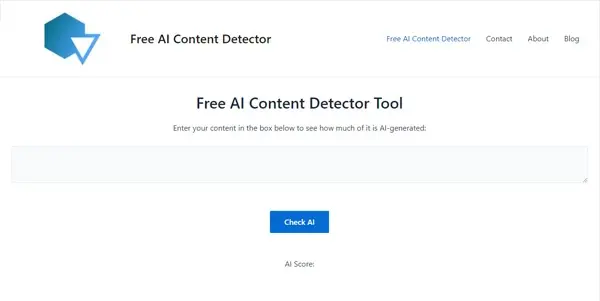Free AI Content Detector

Submit a text and receive a handwriting detection score from an AI
Free AI Content Detector: A Deep Dive into RIP AI's Handwriting Detection Tool
The rise of AI-generated content has brought with it a need for tools to distinguish between human-written and AI-generated text. RIP AI's free AI content detector addresses this need by providing a simple yet effective method for assessing the likelihood that a given text was produced by artificial intelligence. This article will explore its functionality, benefits, applications, and comparison to similar tools.
What Does the Tool Do?
RIP AI's free AI content detector is a tool that analyzes text input and provides a score indicating the probability that the text was generated by an AI. The tool doesn't directly detect handwriting in the traditional sense (analyzing image scans of handwritten text). Instead, it analyzes the style and patterns within the text itself, identifying characteristics often associated with AI-generated content. These characteristics might include consistent sentence structure, predictable vocabulary, lack of stylistic variation, or other subtle linguistic cues. The resulting score is a numerical representation of this analysis, allowing users to gauge the likelihood of AI authorship.
Main Features and Benefits
- Simplicity: The tool's primary benefit is its ease of use. Users simply paste text into the designated field and receive an immediate score. No complex setup or technical expertise is required.
- Free Access: The tool's free pricing model makes it accessible to a wide range of users, from students and bloggers to researchers and professionals.
- Rapid Analysis: The analysis process is remarkably fast, providing near-instant results.
- Clear Output: The scoring system provides a straightforward and easily interpretable result, eliminating ambiguity.
Use Cases and Applications
The free AI content detector finds applications across numerous fields:
- Education: Educators can use the tool to identify potential plagiarism in student submissions, ensuring academic integrity.
- Content Marketing: Content creators can use it to evaluate the quality and originality of AI-generated content before publication, preventing the use of unoriginal or poorly written material.
- Journalism: Journalists can verify the authenticity of online articles and statements, combating the spread of misinformation.
- Research: Researchers can employ the tool to analyze large datasets of text, identifying potential instances of AI-generated content within their studies.
- Legal: In legal contexts, it can aid in determining the authenticity of documents and statements.
Comparison to Similar Tools
While several other AI content detection tools exist, RIP AI's free offering stands out due to its simplicity and accessibility. Many competing tools may offer more advanced features (like identifying specific AI models used), but often come with subscription fees. This free tool provides a valuable baseline level of detection for users who may not require the advanced capabilities of paid alternatives. A direct comparison requires analyzing the specific accuracy and detection capabilities of other tools, which can vary significantly.
Pricing Information
The AI content detection tool offered by RIP AI is completely free to use. There are no hidden fees, subscription costs, or limitations based on usage volume (within reason; extremely high volume usage may be subject to limitations).
Conclusion
RIP AI's free AI content detector provides a valuable resource for anyone needing to assess the probability that a given text was generated by artificial intelligence. Its ease of use, free accessibility, and rapid analysis make it a practical tool across a broad range of applications. While it might not offer the sophisticated features of paid alternatives, its simplicity and free availability make it an extremely valuable asset in the fight against AI-generated misinformation and plagiarism.